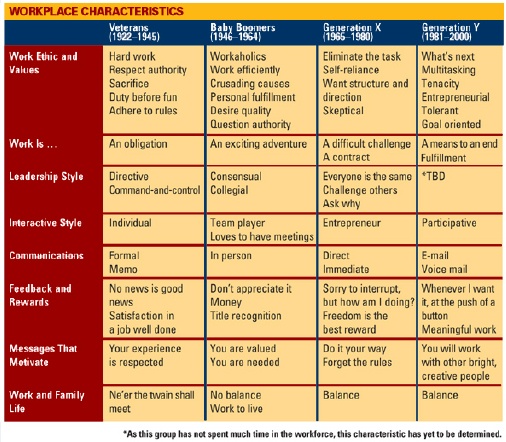In creating a great workplace, where effective strategies are taken into account, the different generational motivations need to be taken into account. There is no “magic pill” when it comes to design or management strategy in answering this challenge. Each organization will have a unique blend of generations in the workplace to motivate. The question is how to keep them all engaged despite their differing motivations.
Management styles cannot be “one size fits all.” Good managers know that showing preferential treatment to anyone for any reason is bad management and can result in litigation, yet managers want to create workplaces where all generations can work together with peace and harmony.
Never before in history have four generations worked in similar jobs in the office space or organization. Today there are four, and in some cases five, generations working side-by-side at the same level or in similar jobs. In the past, the older workers were managers, the middle age groups were valued team members and the youngest generations were part-time trainees or interns. Not so anymore. With the technology revolution this easy hierarchy has disappeared.
Meet the Generations in the Workforce
Veterans: those born between 1930 and 1946, are often remaining in jobs even at post-retirement age for financial reasons or to maintain insurance coverage for an ailing spouse. These employees tend to be pleasant workers, grateful to have avoided the mandatory retirement age.
Baby Boomers: those born from 1946 to 1964, are competitive and many believe younger workers should pay their dues before achieving the same respect, pay, and responsibilities as the Boomer age workers.
Gen X: is the term for those born from 1965 to 1977 and tend to be skeptics and independent minded, disliking too many rules and wanting to work in their own styles.
Gen Y and Millennials: were born after 1977 and these workers enjoy teamwork, feedback and cutting edge up-to-date technology and processes.
We are already seeing those born in the 1990s enter the workplace as part-time advanced education program interns and, as the 2000s continue, they will become part of the next generation in the business place, referred to currently as Generation Zers or Z’erz.
Managers in a great workplace realize they should respond to and address the differences in values and expectations of each generation and take advantage of those differences. In the past, managers tended to “blanket manage”, caring little customized for the generation a group of workers fell into.Today, effectiveness managers take into account, without prejudice, how each working style can benefit their company. This may significantly differ from company to company. Often today’s workspace results in a worker’s immediate supervising manager being younger, even many years younger, than the Senior Manager or Director and so on down the org chart. Keeping a mix of younger and older workers at various levels of responsibility most effectively uses the experience and skill sets of each employee.
Here are some helpful strategies and you can choose those which will best benefit your organization:
Educate Management: Provide in-house or off-site educational classes so management can learn to recognize differences between generations and more easily adapt to them. Managers must change rather than attempting to force staff members to change.The experts from Results Driven Leadership training team can explain how a boss with strong character and skills can be the engine of a successful business.
Encourage Mentoring: It is important for younger employees to learn from the experience of older workers. The older worker can learn new ways to look at things from the younger worker.Unlike the past year, the mentor may well be the younger of the two employees, especially on areas of technology, process change, new work methods, third-place activities and other topics about changes on the cutting edge, yet the mentor is often the older member of the two when the subject is vendor requirements, processes, historic data storage methods and company communication style with client and customers or any of many other topics.
Allow for Adjustment Period: Many workers, primarily older team members, simply do not like change. The older worker may fear working off-site as an “easing out” of the workplace they believe may end up easing them out of the organization but with training and seeing others loving the off-site work capability, they may soon ask to be trained in how to make this method work for them. To build confidence, provide some basic training and perhaps a mentor that has experienced remote working in the past.
Allow for Different Learning / Training Styles: Even within a single generation, there are different learning styles but there is even a bigger difference between generational learning styles. Boomers tend to prefer traditional training such as slide presentations and handouts while younger workers may prefer interactive, technology based training, and mainly computer based training.
Allow for Different Work Styles: Each generation has different work / life goals that result in differing work styles. A great workplace realizes that is is about productivity. So long as your employees are productive and engaged, it does not really matter where or when they work. Keep up to date on current workplace strategies that address these differences.
Employee Engagement: Regular opportunities for growth and development through training and educational opportunities can help keep workers interested in their jobs. Establishing multi-generational task forces to address issues or problems can also help create a robust sense of engagement.
A great workplace will understand and embrace these generational differences.



